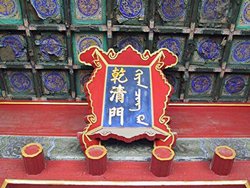Manchu language
|
|
| Manchu (ᠮᠠᠨᠵᡠ [manju]) | |
|---|---|
| Spoken in: | China |
| Region: | Manchuria |
| Total speakers: | 20 to 70 |
| Ranking: | not in top 100 |
| Genetic classification: | Ural-Altaic (disputed)
Altaic (disputed) |
| Official status | |
| Official language of: | - |
| Regulated by: | - |
| Language codes | |
| ISO 639-1 | - |
| ISO 639-2 | mnc |
| SIL | MJF |
| See also: Language – List of languages | |
The Manchu language is a member of the Tungusic languages; it used to be the language of the Manchu, though now most Manchus speak Mandarin Chinese and there are fewer than 100 native speakers of Manchu out of a total of nearly 10 million ethnic Manchus. However, there are about 40,000 speakers of Sibe (Xibo), which is in almost every respect identical to classical Manchu. However, Sibe speakers, who live in far western Xinjiang, are ethnically distinct from Manchus and lay claim as well to the distinctiveness of their language.
It is an agglutinizing language that demonstrates limited vowel harmony, and it has been demonstrated that it is derived in the main from the Jurchen language though there are many loan words from Mongolian and Chinese. Its script is vertically written and taken from the Mongolian alphabet (which in turn derives from Aramaic via Uyghur and Sogdian).
| Contents |
Writing system
The Manchu language uses the Mongol script. For more information, see Manchu Alphabet.
History and significance
Historically, the Manchu language is important in that Europeans were exposed to and familar with Manchu before they encountered the Chinese language. Manchu began as the primary language of the Qing dynasty Imperial court, but by the 19th century even the imperial court had lost fluency in the language. Nevertheless, until the end of the Qing dynasty in 1911, all Imperial documents were drafted in both Manchu and Chinese. Today written Manchu can still be seen in Qing dynasty architecture such as the Forbidden City whose historical signs are written in both Manchu and Chinese characters, and Manchu records are important in the study of Qing-era China.
Very few native Manchu speakers remain; in what used to be Manchuria virtually no one speaks the language with the entire area having been completely sinicized. In fact, the modern custodians of the language are actually the Sibe who live near the Ili valley in Xinjiang and were moved there by Qianlong Emperor in 1764. Modern Sibe is very close to Manchu, although there are a few slight differences in writing and pronunciation; however, the Sibe consider themselves to be separate from the Manchus.
Grammar
As mentioned above Manchu is an agglutinative language, and its basic sentence structure is Subject-Object-Verb (SOV).
Manchu Nouns
Nouns in Manchu have a number of cases which are determined by suffixes:
- nominative - used to mark the subject of a sentence, it is marked by no suffix.
- accusative - used for the direct object of a sentence, it is marked by the suffix -be.
- genitive - used to indicate possession and means by which something is accomplished, it is marked by the suffix -i or the particle ni if coming after a word ending in -ng. For instance, wang ni moo (the king's tree).
- dative/locative - used to indicate location, time or place, or indirect object, it is marked by the suffix -de.
- ablative - used to indicate the origin of an action or in a comparison, it is marked by the suffix -ci.
External links
- Manchu language on Ethnologue (http://www.ethnologue.com/show_language.asp?code=mnc)de:Mandschurische Sprache
nl:Mantsjoe (taal) ja:満州語 pl:Język mandżurski fi:Mantšun kieli zh:满语

